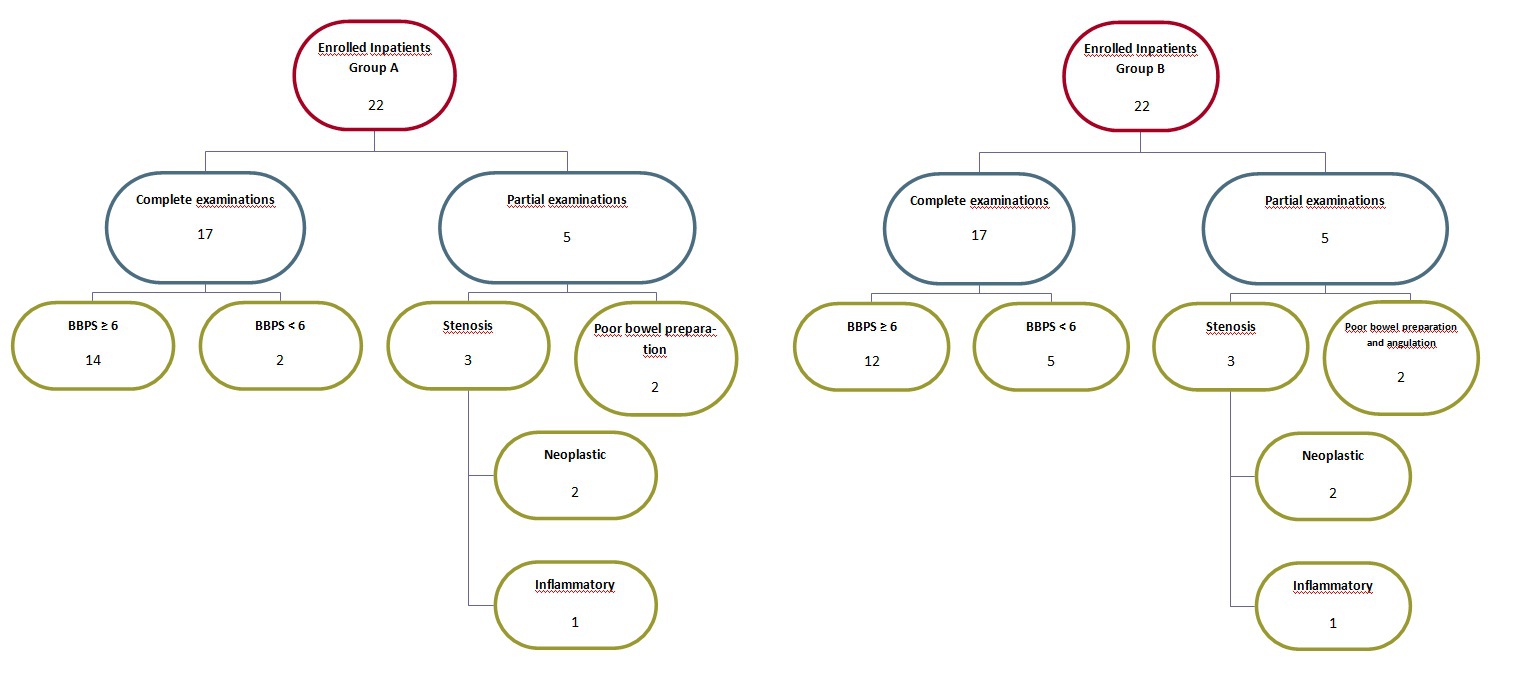|
Back to 2017 Posters
1L PEG BOWEL PREPARATION BEFORE COLONOSCOPY FOR SELECTED HIGH-RISK INPATIENTS IN A PILOT STUDY
Stefano Pontone*, Rossella Palma, Cristina Panetta, Chiara Eberspacher, Paolo Pontone
Department of Surgical Sciences, "Sapienza" University of Rome, Rome, Rome, Italy
AIM - Adequate colonic examination is strictly associated with optimal bowel preparation. Split-dose polyethylene glycol (PEG) based bowel preparation is considered the gold standard in order to obtain an optimal mucosal visualization during colonoscopy. Inpatients are high-risk patient for poor bowel cleansing and often need a quickly diagnosis. The rate of inadequate inpatient bowel preparation is high and associated with a significant increase in hospital length of stay and costs. The timing of colonoscopy is essential to obtain a correct diagnosis in the shortest time and to reduce the length of hospital stay. The aim of our pilot study was to test the efficacy and tolerability of a new same-day low dose, 1 liter, PEG based bowel preparation in hospitalized patients.
METHODS - A single-center prospective pilot study was conducted including all hospitalized patients scheduled to colonoscopy from August 2015 and August 2016 with a consisting suspect of colic stenosis or unable to drink a standard large volume of PEG due their clinical condition. All included patients were divided in two groups receiving: 1L PEG-based on the same day or 4L PEG split dose, performing colonoscopy within 4 hours after the last dose. Patient demographics, medical history and Bristol Stool Scale type were acquired (Tab. 1). Endoscopic data as caecal intubation, withdrawal time, adenoma detection rate and quality of colonic preparation, assessed by the Boston bowel preparation scale (BBPS), were also recorded (Tab. 2).
RESULTS - 44 inpatients (male= 27; mean age 63.5 years; age range=20-94 ) were enrolled between August 2015 and August 2016. 22 patients received 1L PEG-based (Group A) and the others 22 received 4L PEG-based split dose preparation (Group B). The bowel preparation was adequate in fourteen patients of the Group A and in twelve patients of the Group B (Fig. 1). An optimal bowel cleansing was reached in 82% (Group A) and 71% (Group B) of patients. The mean exploration time was 24 and 22 min respectively (caecal intubation rate=77% for both groups). The ADR was 32% (Group A) and 18% (Group B) and ADK rate was 27% and 14% respectively.
CONCLUSION - Our data support that this schedule protocol allows a correct diagnosis in most of patients and show the greater weight of the interval time between the end of the bowel preparation and the beginning of colonoscopy compared to the volume of PEG administered. In our study there are no statistical differences between the two groups in terms of diagnostic rate and successful bowel cleansing achieved. Therefore the same-day low dose 1L PEG-based bowel preparation could be introduced in selected inpatient in order to improve tolerability and to reduce the waiting time in hospitalized high-risk patients. The promising results obtained with our bowel preparation protocol require more randomized trials.
Table 1. Demographics, indications, baseline and procedural characteristics. .
| ---- | Group A | Group B | p Value | | Pts (male) | 22 (68%) | 22 (50%) | | | Median age (range) | 64 (20-86) | 63 (20-94) | | | BMI (mean) | 24.89 | 24.44 | | | Previous colonoscopy | 12 | 8 | | | Smokers | 4 | 2 | | | Concomitant medications | 12 | 10 | | | INDICATIONS | | | | | Haematochezia | 11 | 8 | | | Abdominal Pain | 5 | 1 | | | Anemia | 7 | 1 | | | Constipation | 1 | 1 | | | MEDICAL HISTORY | --- | --- | | | Diabetes | 4 | 3 | | | Inflammatory Bowel Disease | 2 | 1 | | | Hypertension | 7 | 9 | | | ENDOSCOPIC FINDINGS | --- | --- | p Value | | PTS | 22 | 22 | | | Caecal Intubation Rate | 77% | 77% | | | Exploration time (mean) | 24 min | 22 min | | | Withdrawal time (mean) | 10 min | 10 min | | | Ileal exploration | 5 pts (23%) | 3 pts (14%) | | | Adenocarcinoma Rate | 27% | 14% | ns | | Adenoma Detection Rate | 32% | 18% | ns | | Optima bowel cleansing* | 82% | 71% | |
BMI = body mass index; (a) Multiple indications possible;* BBPS ≥6 with all segments ≥ 2(excluding incomplete examinations 
Back to 2017 Posters
|


